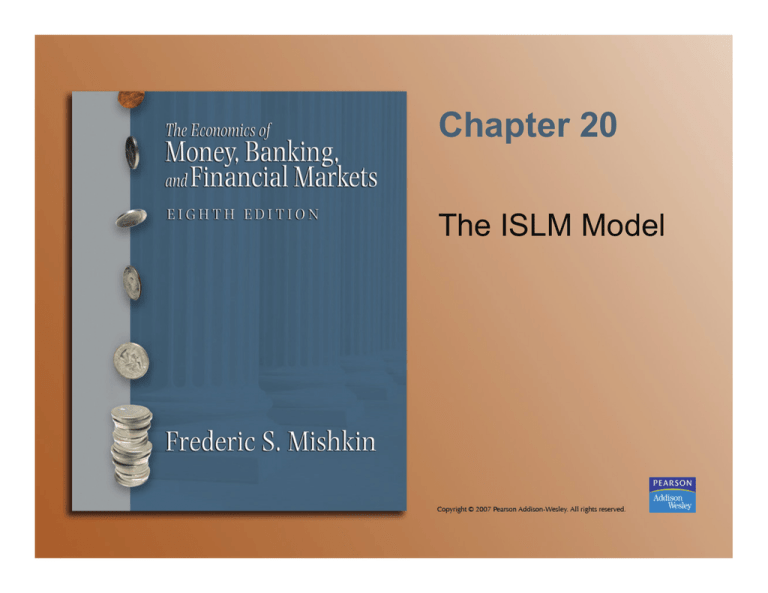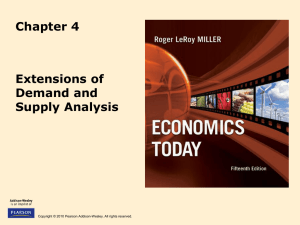
Chapter 20
The ISLM Model
Determination of Aggregate Output
The total quantity demanded of an economy's
output is the sum of four types of spending
Y ad = C + I + G + NX
Equilibrium occurs in the economy
when the total quantity of output supplied
equals the total quantity of output demanded
Y = Y ad
Analysis assumes the price level is fixed
Copyright © 2007 Pearson Addison-Wesley. All rights reserved.
20-2
Consumption Expenditure and the
Consumption Function
Income is the most important factor determining consumption spending
Disposable income (YD ) is total income less taxes (Y - T)
The marginal propensity to consume (mpc) is the slope of
the consumption function (C / YD ), the change in consumer
expenditure that results from an additional dollar of disposable income
a is automonous consumer expenditure, the amount of consumer
expenditure that is independent of disposable income (how much
will be spent when disposable income is 0)
C = a + mpc(YD )
Copyright © 2007 Pearson Addison-Wesley. All rights reserved.
20-3
Copyright © 2007 Pearson Addison-Wesley. All rights reserved.
20-4
Copyright © 2007 Pearson Addison-Wesley. All rights reserved.
20-5
Investment Spending
• Fixed investment—always planned
• Inventory investment—can be
unplanned
• Planned investment spending
Interest rates
Expectations
Copyright © 2007 Pearson Addison-Wesley. All rights reserved.
20-6
Copyright © 2007 Pearson Addison-Wesley. All rights reserved.
20-7
Expenditure Multiplier
A change in planned investment spending leads to an even larger
change in aggregate output
An increase in planned investment spending leads to an
additional increase in consumer expenditure which raises aggregate
demand and output further
1
)I
Y = (
1 mpc
1
Y / I = (
)
1 mpc
Copyright © 2007 Pearson Addison-Wesley. All rights reserved.
20-8
Copyright © 2007 Pearson Addison-Wesley. All rights reserved.
20-9
Copyright © 2007 Pearson Addison-Wesley. All rights reserved.
20-10
Changes in Autonomous Spending
Any change in autonomous spending will lead to a multiplied
change in aggregate output
1
)
Y = (a + I )(
1 mpc
The shift in the aggregate demand function can come from a
change in planned investment, a change in autonomous
consumer spending, or both
Changes in autonomous spending are dominated by
animal spirits
Copyright © 2007 Pearson Addison-Wesley. All rights reserved.
20-11
Government’s Role
Government spending and taxes
can be used to change the position of the
aggregate demand function
Government spending adds directly
to aggregate demand
Taxes do not affect aggregate demand directly
C = a + [mpc (Y T )] = a + (mpc Y ) (mpc T )
If taxes change, consumer expenditure changes
in the opposite direction
C = -mpc T
Copyright © 2007 Pearson Addison-Wesley. All rights reserved.
20-12
Copyright © 2007 Pearson Addison-Wesley. All rights reserved.
20-13
Role of International Trade
A change in net exports (exports - imports) is positively
related to changes in aggregate output
1
)
Y = NX (
1 mpc
Copyright © 2007 Pearson Addison-Wesley. All rights reserved.
20-14
Copyright © 2007 Pearson Addison-Wesley. All rights reserved.
20-15
Copyright © 2007 Pearson Addison-Wesley. All rights reserved.
20-16
The ISLM Model
• Includes money and interest rates in the
Keynesian framework
• Examines an equilibrium where aggregate output
equals aggregate demand
• Assumes fixed price level where nominal and real
quantities are the same
• IS curve is the relationship between equilibrium
aggregate output and the interest rate
• LM curve is the combinations of interest rates and
aggregate output for which MD = MS
Copyright © 2007 Pearson Addison-Wesley. All rights reserved.
20-17
Equilibrium in the Goods Market:
The IS Curve
• Interest rates and planned investment spending
Negative relationship
• Interest rates and net exports
Negative relationship
• The points at which the total quantity of goods
produced equals the total quantity of goods demanded
• Output tends to move toward points on the curve that
satisfies the goods market equilibrium
Copyright © 2007 Pearson Addison-Wesley. All rights reserved.
20-18
Copyright © 2007 Pearson Addison-Wesley. All rights reserved.
20-19
Copyright © 2007 Pearson Addison-Wesley. All rights reserved.
20-20
Copyright © 2007 Pearson Addison-Wesley. All rights reserved.
20-21
Equilibrium in the Market for Money:
The LM Curve
• Demand for money called liquidity
preference
• Md/P depends on income (Y) and
interest rates (i)
• Positively related to income
Raises the level of transactions
Increases wealth
• Negatively related to interest rates
Copyright © 2007 Pearson Addison-Wesley. All rights reserved.
20-22
Equilibrium in the Market for Money:
The LM Curve (cont’d)
• Connects points that satisfy the
equilibrium condition that MD = MS
• For each level of aggregate output, the
LM curve tells us what the interest rate
must be for equilibrium to occur
• The economy tends to move toward
points on the LM curve
Copyright © 2007 Pearson Addison-Wesley. All rights reserved.
20-23
Copyright © 2007 Pearson Addison-Wesley. All rights reserved.
20-24
Copyright © 2007 Pearson Addison-Wesley. All rights reserved.
20-25








